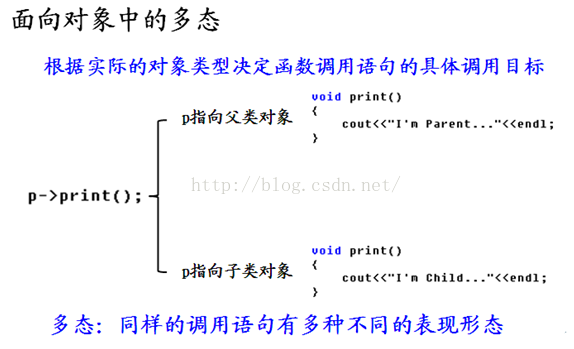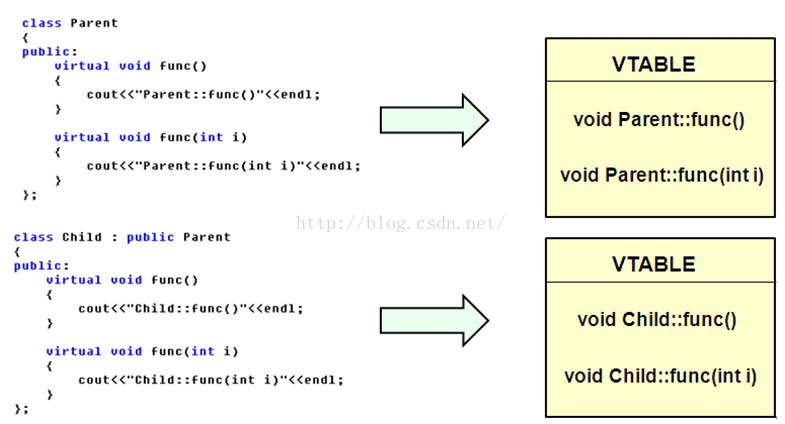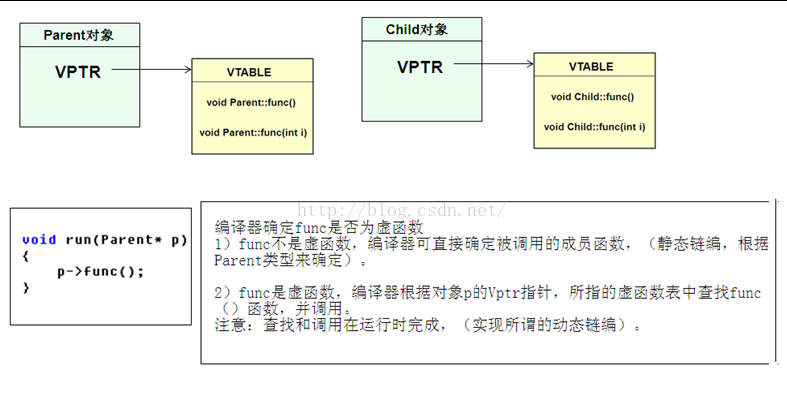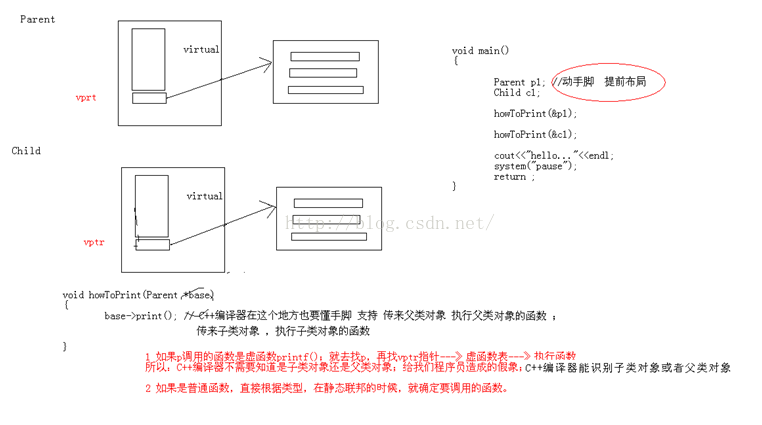Summary of C++ Review Key Points No. 10 - Polymorphism (1)
Understanding of polymorphism:
is a new object-oriented requirement:
Judge the call of the rewritten function based on the actual object type
If the parent class pointer points to If it is a parent class object, call the function defined in the parent class
If the parent class pointer points to a subclass object, call the overridden function defined in the subclass

Solution:
Ø C++ supports polymorphism through the virtual keyword
Ø Functions declared using virtual can be rewritten to exhibit polymorphic features
//Three major concepts of object-oriented
Encapsulation
breaks through the concept of C language functions. .
Inheritance
Code reuse. . . . I reuse the code I originally wrote. . .
Polymorphism
Polymorphism can use the future. . . . . A framework was written in the 1980s. . . . . . Code written by people in the 1990s
Polymorphism is a goal pursued by our software industry. . .
//Written a framework that can call on the ability of code written by later generations
Further understanding
//Three conditions for indirect assignment to be established:
//1 Define two variables. . .
//2 Establish association. . . .
//3 *p
//Three conditions for polymorphism to be established:
//1 There must be inheritance
//2 There must be Function rewriting. . . C virtual function
//3 There must be a parent class pointer (parent class reference) pointing to the subclass object
//Polymorphism is the basis of the design pattern, and polymorphism is the basis of the framework
Knowledge point 1 Virtual destructor
The destructor is to release resources.
When there is a need to release resources and the object cannot be released directly, such as:
C *myC = new C; //C inherits B, and B inherits class A
delete myC; //Release resources directly through subclass objects. In this case, there is no need to write the virtual keyword
Need to execute the destructors of all subclasses and objects through the parent class pointer
If you want to release all subclass resources through the parent class pointer (you need to add it in the final parent class destructor virtual keyword)
void howtodelete(A *base)
{
delete base; //这句话不会表现成多态 这种属性
}Knowledge point 2: The difference between overloading and rewriting
Function overloading
Must be done in the same class
Subclasses cannot overload functions of the parent class. Functions of the same name in the parent class will be overwritten by name (for example: there is function a() in the parent class, and there is also function a() in the subclass, but there is also function a(). int b) This function generates an error by overloading the parent class function! )
Overloading determines the function call based on the parameter type and number during compilation
Function rewriting
Must occur between the parent class and the subclass
And the functions in the parent class and the subclass must have exactly the same prototype
Using virtual declaration can produce polymorphism ( If virtual is not used, it is called redefinition)
Polymorphism determines function calls based on the type of specific objects during runtime
Example analysis:
//1 C++编译器 看到func名字 ,因子类中func名字已经存在了(名称覆盖).所以c++编译器不会去找父类的4个参数的func函数 //2 c++编译器只会在子类中,查找func函数,找到了两个func,一个是2个参数的,一个是3个参数的. //3 C++编译器开始报错..... error C2661: “Child::func”: 没有重载函数接受 4 个参数 //4 若想调用父类的func,只能加上父类的域名..这样去调用.. c1.func(1, 3, 4, 5); //c1.func(); //func函数的名字,在子类中发生了名称覆盖;子类的函数的名字,占用了父类的函数的名字的位置 //因为子类中已经有了func名字的重载形式。。。。 //编译器开始在子类中找func函数。。。。但是没有0个参数的func函数
3 Key points:
The implementation principle of polymorphism in C++
When a virtual function is declared in a class, the compiler will generate a virtual function table in the class
The virtual function table is A data structure that stores class member function pointers
The virtual function table is automatically generated and maintained by the compiler
Virtual member functions will be placed in the virtual function table by the compiler
When there is a virtual function, each object has a pointer to the virtual function table (vptr pointer)



Note 1:
Calling the rewritten function through the virtual function table pointer VPTR is performed when the program is running, so addressing operation is required to determine the function that should actually be called. . For ordinary member functions, the function to be called is determined at compile time. In terms of efficiency, virtual functions are much less efficient.
Note 2:
For efficiency reasons, it is not necessary to declare all member functions as virtual functions
Note 3: The C++ compiler executes the HowToPrint function, which is not required Distinguish whether it is a subclass object or a parent class object

The above is the ten summary of C++ review points - polymorphism (1). For more related content, please pay attention to PHP Chinese Net (www.php.cn)!

Hot AI Tools

Undresser.AI Undress
AI-powered app for creating realistic nude photos

AI Clothes Remover
Online AI tool for removing clothes from photos.

Undress AI Tool
Undress images for free

Clothoff.io
AI clothes remover

AI Hentai Generator
Generate AI Hentai for free.

Hot Article

Hot Tools

Notepad++7.3.1
Easy-to-use and free code editor

SublimeText3 Chinese version
Chinese version, very easy to use

Zend Studio 13.0.1
Powerful PHP integrated development environment

Dreamweaver CS6
Visual web development tools

SublimeText3 Mac version
God-level code editing software (SublimeText3)

Hot Topics
 Concurrency-safe design of data structures in C++ concurrent programming?
Jun 05, 2024 am 11:00 AM
Concurrency-safe design of data structures in C++ concurrent programming?
Jun 05, 2024 am 11:00 AM
In C++ concurrent programming, the concurrency-safe design of data structures is crucial: Critical section: Use a mutex lock to create a code block that allows only one thread to execute at the same time. Read-write lock: allows multiple threads to read at the same time, but only one thread to write at the same time. Lock-free data structures: Use atomic operations to achieve concurrency safety without locks. Practical case: Thread-safe queue: Use critical sections to protect queue operations and achieve thread safety.
 C++ object layout is aligned with memory to optimize memory usage efficiency
Jun 05, 2024 pm 01:02 PM
C++ object layout is aligned with memory to optimize memory usage efficiency
Jun 05, 2024 pm 01:02 PM
C++ object layout and memory alignment optimize memory usage efficiency: Object layout: data members are stored in the order of declaration, optimizing space utilization. Memory alignment: Data is aligned in memory to improve access speed. The alignas keyword specifies custom alignment, such as a 64-byte aligned CacheLine structure, to improve cache line access efficiency.
 How to implement a custom comparator in C++ STL?
Jun 05, 2024 am 11:50 AM
How to implement a custom comparator in C++ STL?
Jun 05, 2024 am 11:50 AM
Implementing a custom comparator can be accomplished by creating a class that overloads operator(), which accepts two parameters and indicates the result of the comparison. For example, the StringLengthComparator class sorts strings by comparing their lengths: Create a class and overload operator(), returning a Boolean value indicating the comparison result. Using custom comparators for sorting in container algorithms. Custom comparators allow us to sort or compare data based on custom criteria, even if we need to use custom comparison criteria.
 Similarities and Differences between Golang and C++
Jun 05, 2024 pm 06:12 PM
Similarities and Differences between Golang and C++
Jun 05, 2024 pm 06:12 PM
Golang and C++ are garbage collected and manual memory management programming languages respectively, with different syntax and type systems. Golang implements concurrent programming through Goroutine, and C++ implements it through threads. Golang memory management is simple, and C++ has stronger performance. In practical cases, Golang code is simpler and C++ has obvious performance advantages.
 How to implement the Strategy Design Pattern in C++?
Jun 06, 2024 pm 04:16 PM
How to implement the Strategy Design Pattern in C++?
Jun 06, 2024 pm 04:16 PM
The steps to implement the strategy pattern in C++ are as follows: define the strategy interface and declare the methods that need to be executed. Create specific strategy classes, implement the interface respectively and provide different algorithms. Use a context class to hold a reference to a concrete strategy class and perform operations through it.
 How to copy a C++ STL container?
Jun 05, 2024 am 11:51 AM
How to copy a C++ STL container?
Jun 05, 2024 am 11:51 AM
There are three ways to copy a C++ STL container: Use the copy constructor to copy the contents of the container to a new container. Use the assignment operator to copy the contents of the container to the target container. Use the std::copy algorithm to copy the elements in the container.
 What are the underlying implementation principles of C++ smart pointers?
Jun 05, 2024 pm 01:17 PM
What are the underlying implementation principles of C++ smart pointers?
Jun 05, 2024 pm 01:17 PM
C++ smart pointers implement automatic memory management through pointer counting, destructors, and virtual function tables. The pointer count keeps track of the number of references, and when the number of references drops to 0, the destructor releases the original pointer. Virtual function tables enable polymorphism, allowing specific behaviors to be implemented for different types of smart pointers.
 How to implement C++ multi-thread programming based on the Actor model?
Jun 05, 2024 am 11:49 AM
How to implement C++ multi-thread programming based on the Actor model?
Jun 05, 2024 am 11:49 AM
C++ multi-threaded programming implementation based on the Actor model: Create an Actor class that represents an independent entity. Set the message queue where messages are stored. Defines the method for an Actor to receive and process messages from the queue. Create Actor objects and start threads to run them. Send messages to Actors via the message queue. This approach provides high concurrency, scalability, and isolation, making it ideal for applications that need to handle large numbers of parallel tasks.






